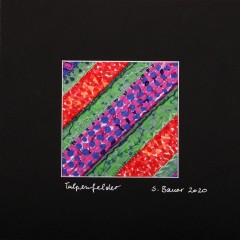Sybille Bauer
Poppy. In other pictures, however, red can seem threatening or indicate blood. Poppies, however, are about the joy of colourful blossoms. They have completely detached themselves from nature. The shape of their leaves and stems comes from the realm of fantasy. Even their white background remains mysterious. Do they lie on a tablecloth? Do they bloom even though there is still snow? Do these questions really need to be answered?
These tulip fields look as if they were photographed from a drone. Spring is already far advanced, so that they could fully unfold their blaze of colour. The strictly geometrical structure of the picture with the fields running at a 45° angle to the picture frame, however, signals that this is not just about beauty, but about the tulip as a commodity.
Only in art is it possible for a RHİNOCERVS depicted in a woodcut by Albrecht Dürer in 1515 to shed its shell and take on a different form, namely that of a RHİNOCERVS in silk roses. Dürer did not depict a rhinoceros at all, but his ideas about this animal. He had developed them not by seeing them himself, but by describing and sketching someone else. Only the outline of the RHİNOCERVS in SeidenRosen can be seen. This too, however, is interrupted by several embroidered silk roses. Nevertheless, the RHİNOCERVS retains its massiveness, supported by the static posture. And yet the Chinese silk manages to give it a certain elegance. No frame should capture this motif.
Since the Romantic period, the forest has been a romantic myth in Germany. This is all the more true of an oak forest. So why not stage an opera in the forest? The Magic Flute in the Oak Forest deals with the effect of music on the falling leaves. They dress up in ornaments to suit the occasion. Individual ornaments make themselves independent on the sheet of music.

